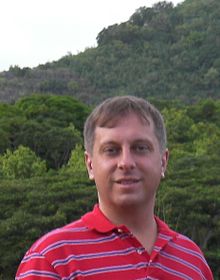Marin Soljačić
Marin Soljačić | |
|---|---|
 | |
| Born | February 7, 1974 |
| Nationality | Croatian |
| Alma mater | Massachusetts Institute of Technology |
| Known for | WiTricity, Nonlinear optics |
| Awards | Adolph Lomb Medal (2005) TR35 (2006) MacArthur Fellowship (2008)[1] Blavatnik Award for Young Scientists (2014)[2] Max Born Award (2023) |
| Scientific career | |
| Fields | Physicist and Electrical Engineer |
| Institutions | Massachusetts Institute of Technology |
| Doctoral advisor | Mordechai Segev[3] |
| Notable students | Prineha Narang |
Marin Soljačić (born February 7, 1974) is a Croatian-American physicist and electrical engineer known for wireless non-radiative energy transfer.
Biography
Marin Soljačić was born in Zagreb in 1974. After graduating from XV Gymnasium (MIOC) in Zagreb he attended MIT, where he got his BSc in physics and electrical engineering in 1996.[4] In 1998 he got his MSc from Princeton University and in 2000 he got his PhD in Physics. In 2005 he became a professor of Physics at MIT.[5] In 2008, he was awarded a MacArthur Fellowship.[6][7]
Work
In 2007 Marin Soljačić and his assistants successfully made the first efficient non-radiative power transfer at a distance of 2 meters turning on a 60 W light bulb. Energy transfer was 40% efficient. Professor Soljačić's experiments and work in wireless energy transfer are related in spirit to the work of Nikola Tesla in the early 20th century, [8] but also have significant differences: unlike Tesla's long-range wireless energy transfer in Colorado, the Soljačić group focuses only on short-range transfer, and unlike Tesla coils which resonantly transfer power with electric fields (which couple strongly to surrounding matter, most famously inducing artificial lightning) the Soljačić proposal uses coupling primarily via magnetic fields.[8] This work is currently being pursued in Soljačić's WiTricity company. Soljačić believes that low-power commercial application of this technology, such as charging of mobile phones, is several years away. [9]
In addition to wireless energy transfer, Prof. Soljačić works on numerous problems on electromagnetism [10] in materials structured on the scale of the wavelength, such as micro- and nano-structured materials for infrared and visible light, including nonlinear optical devices and surface plasmons. His more recent research, supported by a US$20 million grant from the U.S. Department of Energy, focuses on the use of photonic crystals in solar cells. [9]
References
- ^ "2008 MacArthur Fellows: Marin Soljačić". macfound.org. John D. and Catherine T. MacArthur Foundation. September 2008. Archived from the original on 2010-06-19. Retrieved 2010-05-22.
- ^ "Blavatnik National Awards for Young Scientists Announce 2014 National Laureates - Yahoo Finance". Archived from the original on 2014-08-12. Retrieved 2017-01-17.
- ^ "Marin Soljačić". vecernji.hr (in Croatian). December 1, 2016. Retrieved 2017-07-04.
- ^ MIT home page
- ^ "Marin Soljačić, Professor of Physics". web.mit.edu.
- ^ "For Hopkins Astronomer And 24 Others, The Stars Align". The Washington Post.
- ^ "IEEE Spectrum report". Archived from the original on 2008-11-03. Retrieved 2008-09-24.
- ^ a b Kurs, André; Karalis, Aristeidis; Moffat, Robert; Joannopoulos, J. D.; Fisher, Peter; Soljačić, Marin (2007). "Wireless power transfer via strongly coupled magnetic resonances". Science. 317 (5834): 83–86. Bibcode:2007Sci...317...83K. CiteSeerX 10.1.1.418.9645. doi:10.1126/science.1143254. PMID 17556549. S2CID 17105396.
- ^ a b Rudež, Tanja (May 22, 2010). "Marin Soljačić: Vjerujem da za dvije ili tri godine više nećete trebati punjače za mobitel" [Marin Soljačić: I believe that in two or three years you will no longer going to need mobile phone chargers]. Jutarnji list (in Croatian). Retrieved 2010-05-22.
- ^ Soljačić, Marin; Lidorikis, Elefterios; Joannopoulos, J. D.; Hau, Lene Vestergaard (25 April 2005). "Ultralow-power all-optical switching" (PDF). Applied Physics Letters. 86 (17): 171101. arXiv:physics/0406001. Bibcode:2005ApPhL..86q1101S. doi:10.1063/1.1900956. S2CID 2742135.
External links
- BBC article explaining non-radiative power transfer
- TED presentation on technology application
- Marin Soljačić publications indexed by Google Scholar
- 1974 births
- Living people
- Croatian physicists
- 21st-century American physicists
- Croatian emigrants to the United States
- MacArthur Fellows
- MIT School of Engineering alumni
- Massachusetts Institute of Technology School of Science faculty
- Scientists from Zagreb
- 21st-century Croatian scientists
- MIT Department of Physics alumni
